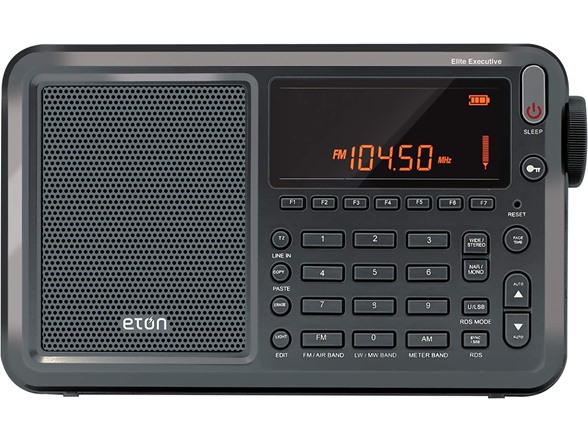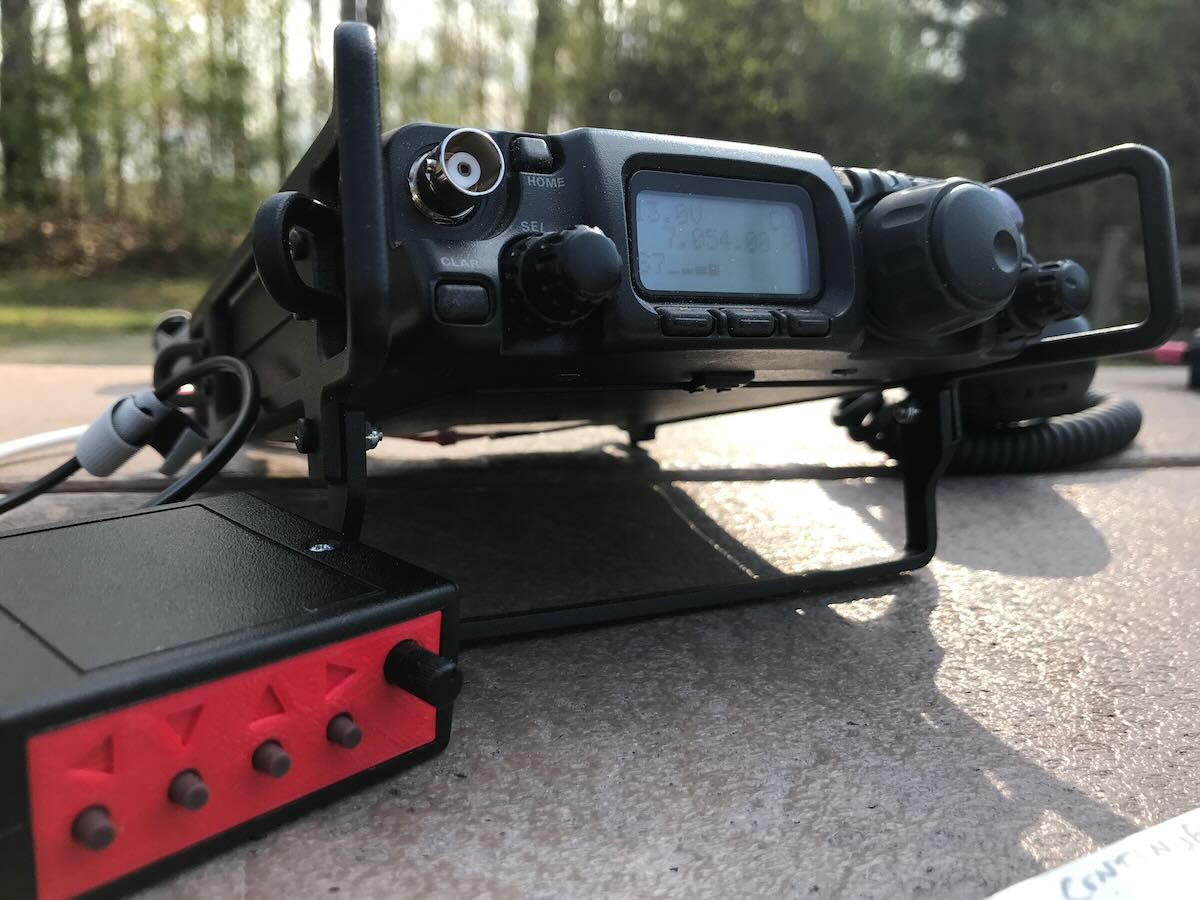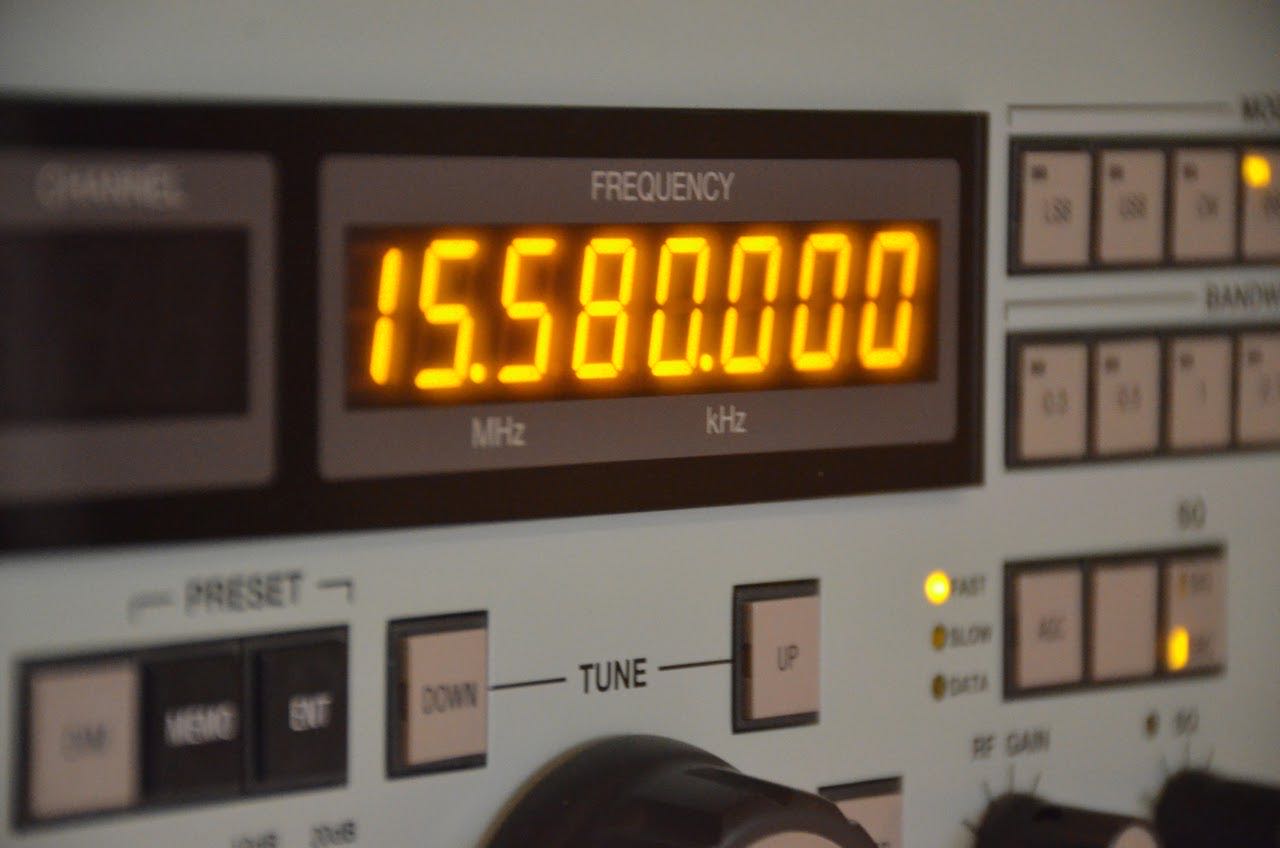 Many thanks to SWLing Post contributor, Ulis (K3LU), who notes that the discount retailer Woot has the Eton Elite Executive on sale for $79.99 US.
Many thanks to SWLing Post contributor, Ulis (K3LU), who notes that the discount retailer Woot has the Eton Elite Executive on sale for $79.99 US.
Thanks so much for the tip, Ulis!

 Many thanks to SWLing Post contributor, Ulis (K3LU), who notes that today is the annual Armed Forces Day Crossband Test.
Many thanks to SWLing Post contributor, Ulis (K3LU), who notes that today is the annual Armed Forces Day Crossband Test.
Click here to download a PDF document with all details including frequencies, schedule, and QSL info. Thanks for the tip, Ulis!
 Many thanks to SWLing Post contributor, Ulis (K3LU), who shares the following note via his Twitter feed:
Many thanks to SWLing Post contributor, Ulis (K3LU), who shares the following note via his Twitter feed:
“Comrade Africa” – a historic look at the GDR’s (Radio Berlin International) Cold War era shortwave broadcasts to Africa via the BBC World Service:
Click here to listen to the documentary at the BBC World Service.
Because I keep my ear to the waves, as well as receive many tips from others who do the same, I find myself privy to radio-related stories that might interest SWLing Post readers. To that end: Welcome to the SWLing Post’s Radio Waves, a collection of links to interesting stories making waves in the world of radio. Enjoy!
Many thanks to SWLing Post contributors David Shannon, Sheldon Harvey (Int. Radio Report), Jorge Garzón Gutiérrez, and Ulis Fleming for the following tips:
European DX listeners have recently discovered a wonderful new target. On 27 MHz it is possible to receive Catholic mass celebrations from Ireland and Northern Ireland. Hundreds of local churches around the island are broadcasting holy masses live. If you tune in between 27000 and 28000 kHz, you might be able to hear many interesting churches. The transmitter power is usually only 3 watts, so a strong F2 opening is needed. Luckily with the current solar maximum this happens quite often.
How did all this start? This is a fascinating story, told by a Father, who has been helping the idea to become reality.
The broadcasting of Masses was introduced in a rural Irish diocese over 30 years ago when the resident priest was considering a way of reaching out to those who were housebound in his parish. They had access to religious broadcasts on National Radio and TV, but he knew that it was no comparison to a local broadcast. There were many incidents of families coming home from Mass on Sunday and their housebound parent or grandparent had ‘all the news’ (they were aware of all the happenings in the parish) when they arrived home.[…]
Click here to continue reading at DXing.info.
Decades before Spotify, Pandora, and even satellite radio, terrestrial (land-based) AM and FM radio reigned supreme. Many listeners, including Utica resident Ron Robinson, idolized the disc jockeys just as much as the artists they played.
Robinson, 51, is working on a documentary film entitled “Radio Dayz… The Movie,” which focuses on the history of radio, including the early days of Detroit radio. “(The film) tells the story of radio through the people who worked in radio,” he said.
Robinson interviewed several well-known radio personalities such as Paul W. Smith, Dick Purtain, Fred Jacobs, Dick Kernen, and more for the film. Robinson, who worked for WJR for 20 years before starting his own production company, has several connections in the industry. He started interviewing for the documentary in 2013.
“Most people think of radio, they think of New York, California, and Chicago, and rightfully so. But, Detroit has been an important and ground-breaking city for the medium of radio,” Robinson said.
The documentary is a chronological look at the history of radio, starting with the first radio stations. It also takes aim at the first radio “celebrity,” Fr. Charles Coughlin. The Detroit-area priest took to the airways in the 1920s and eventually garnered an audience of 30 million to his weekly radio show. Coughlin would later become a polarizing figure as World War II approached. “He’s on the wrong side of history, if you will,” Robinson said.
[…]
Often I get surprised when I listen to the FM Band with my autoradio. It has no bandwidth options, no filters, but sensitivity and selectivity are much better than most of the well-know portables. Mine is inserted into the Skoda console so I have no way to know who manufactured it, the brand/model or its tech specifications. Most of the times I wonder why other portable firmwares does not include, for instance, similar choices like the high speed decoding RDS info. Then I thought… Will be my ULR Sangean DT-800 up to the task?
An autoradio like mine (SKODA Spaceback car) decodes RDS and hears weak signals at once. It is part of a well balanced system: receiver-feedline and rubber antenna on the metallic car roof. My pocket ultralight radios use the earphone cable as an aerial, so even being very good receivers, the antenna is far to be reliable with tricky and changing reception as it depends on the cable position at every moment. Uhmmm! I needed to find a better way to listen using my small toys.
In the shack I had some whips with male BNC and PL-359 connectors, but the Pocket ULR has a 3,5 mm female plug-in, so I found a “female BNC > male jack 3,5 mm” adapter and connected the whip. I chose a telescopic antenna 20/115 cm long folded/unfolded to test the Sangean DT-800T versus the SKODA autoradio, focused on the BOTB from 87,5 to 91,5 MHz. When a long whip is used some unwanted effects come into the scene. The first is related with audio; connecting the whip the sound must be heard via the small speaker so don’t forget to choose a quiet environment not to miss weak stations. The second one is pure physics; due to the whip length, the ULR 3,5 mm female plug-in gets extra strain and that could damage the inner weldings, so extra care must be kept in mind at any time.[…]
Read the full article at Ideria DX.
Many thanks to SWLing Post contributor, Matt, who shares a link to a radio classifieds site he has created. Check it out!
The UsedRadioMall.com web site lists radios and items related to the subject of radio. The list may include receivers, transmitters, transceivers, amplifiers, antennas, parts, and components related to amateur radio, two-way radio, cb radio, broadcasting, recording, production, and hi-fi.
Introduction
Changes in ionospheric electron density caused by space weather and diurnal solar changes are known to cause Doppler shifts on HF ray paths. For example, see Figure 7 in Boitman et al., 1999. As part of the WWV centennial, 50 stations collected Doppler shift data for the original Festival of Frequency Measurement, demonstrating the value of volunteer participation in collecting this data. This June, we request that all amateur radio stations, shortwave listeners, and others capable of making high-quality HF frequency measurements help us collect frequency data for the June 10 annular eclipse. Researchers will use the crowdsourced data to investigate the superimposed effects of auroral particle precipitation and the eclipse on Doppler shift.
All you need to collect data is an HF rig connected to a computer running open-source software. A precision frequency standard, such as a GPS-disciplined oscillator, is desired but not required to participate. All ham operators and shortwave listeners around the globe are invited to join in, even if your station is far from the path of totality. Last year’s eclipse festivals included over 100 participants from 45 countries. The experiment will run from 7-12 June. All participants will receive QSL certificates and updates as the data is processed. This is a pilot experiment for HamSCI’s Personal Space Weather Station project, which seeks to develop a global network monitoring the geospace environment.
Contact information:
Kristina Collins: [email protected]
Click here to read the full article at HamSci.org.
Please consider supporting us via Patreon or our Coffee Fund!
Your support makes articles like this one possible. Thank you!
Because I keep my ear to the waves, as well as receive many tips from others who do the same, I find myself privy to radio-related stories that might interest SWLing Post readers. To that end: Welcome to the SWLing Post’s Radio Waves, a collection of links to interesting stories making waves in the world of radio. Enjoy!
Many thanks to SWLing Post contributors Ulis (K3LU), Chris Walter, and Ron James for the following tips:
SpaceX doesn’t operate like a traditional aerospace company. For one, the CEO is usually hamming it up on Twitter during launches and providing details that would usually go in a press release. SpaceX also live streams almost all of its launches, even the prototypes that have an unfortunate tendency to blow up lately. It wasn’t even encrypting the Falcon 9 telemetry feed… until now. Unfortunately, some digging by amateur radio tinkerers seems to have convinced SpaceX to step up its security.
It all started a few weeks ago when several Redditors managed to lock onto the 2232.5 MHz telemetry downlink from a Falcon 9 upper stage. Right away, they were able to pull out a few interesting plaintext snippets from the unencrypted feed. With a little more work, the radio enthusiasts were able to capture some amazing images from the spacecraft’s cameras.
After that discovery was public, other SpaceX fans tried to grab some data from the Starship during its prototype tests. However, SpaceX had chosen to encrypt that data. Even with the right wireless equipment, the decoded signal was just noise. Now, it appears the same thing is happening with the Falcon 9. When attempting to pull data from the most recent Falcon 9 launch, the original signal snoopers discovered it had also been encrypted. A series of tweets from SpaceX engineers suggest the decoding of the telemetry signal was the reason for the change.[…]
BOSTON — A postcard written by the Titanic’s senior radio operator just weeks before the ocean liner sank in the North Atlantic in 1912 has been put up for auction.
The card, with a glossy image of the ill-fated ship on the front, was written by Jack Phillips to his sister, Elsie Phillips, in March 1912 while awaiting the ship’s first sea trials, according to RR Auction in Boston.
“Very busy working late. Hope to leave on Monday & arrive Soton Wednesday afternoon. Hope you quite OK. Heard from Ethel yesterday,” he wrote. It’s signed “Love Jack.”
It is postmarked Belfast, where the Titanic was built, and has a canceled halfpenny stamp.
“Soton” is a contraction of Southampton, the English port city from where the Titanic departed on its maiden voyage. It sank in the early morning hours of April 15.
Phillips, who turned 25 on board, stayed at his post after the Titanic struck an iceberg to send calls for assistance to other ships in the area until water was lapping around his feet, according to RR Auction.
He made it off the ship after being told by the captain that he had done his duty, according to his biography in the British National Archives, but died of exposure in the frigid North Atlantic, according to RR Auction.
The postcard is being sold by the estate of Vera and John Gillespie, longtime members of the Massachusetts-based Titanic Historical Society, said Bobby Livingston, executive vice president at RR Auction.[…]
What is sound art? And what do we know about its origin story? We explore this question and more with our guest this week, artist and educator Judy Dunaway. An adjunct professor in the History of Art Department at Massachusetts College of Art and Design, Dunaway’s recent article, “The Forgotten 1979 MoMA Sound Art Exhibition,” is a fascinating look at the history of sound art and highlights important contributions by female artists. In our wide-ranging discussion, we also hear about Dunaway’s own artistic practice, from her work with latex balloons to transmission art to a “phone improv” show over BlogTalkRadio a decade ago.
Click here to check out this piece at Radio Survivor.
A MATTER OF RECORD: Mighty useful gadgets are WNYC’s four new recording machines. They were used in a variety of interesting ways during the past year, so we decided that the how and the why of recording would be an appropriate subject for this, the third of our Behind the Microphone series dealing with the technical side of things at the Municipal Station.
One of the most valuable uses of the recording units is that they have partially enabled us to overcome the limitations of time — have made it possible to make available to our listeners important evening programs which we could not broadcast directly because of our fluctuating time allotment.
For instance, we could not pick up the ASCAP Music Festival Concerts from Carnegie Hall last Fall because WNYC was not on the air after 8:30 P. M.[1] What to do? The recorders to the rescue! The concerts were “broadcast” over our regular Carnegie Hall lines to the Municipal Building where they were transcribed on our two standard studio-type recording machines. Each transcription[2] was put on the air on the afternoon following the original perfor
Similarly, our two mobile recording units made possible an afternoon broadcast of the official opening of La Guardia Field which took place at midnight. Recording equipment is also used frequently to transcribe major programs “off the air” so that they may reach a larger audience through rebroadcast. There was the time, for example, when the Mayor’s office was the scene of a final report on the new Police and Fireman’s pension plan. Official reports on the balloting were recorded and rebroadcast at a time when the majority of the policemen and firemen affected could listen in.
We used to think recording an easy job: Just put the recording needle on the disk, turn a few buttons, and let ‘er go. After watching one of our expert recording engineers at work, we realized that it’s a delicate task, requiring special training and long practice.
Click here to read the full piece at WNYC.
Please consider supporting us via Patreon or our Coffee Fund!
Your support makes articles like this one possible. Thank you!
 Radio Waves: Stories Making Waves in the World of Radio
Radio Waves: Stories Making Waves in the World of RadioBecause I keep my ear to the waves, as well as receive many tips from others who do the same, I find myself privy to radio-related stories that might interest SWLing Post readers. To that end: Welcome to the SWLing Post’s Radio Waves, a collection of links to interesting stories making waves in the world of radio. Enjoy!
Many thanks to SWLing Post contributors Mike Terry, Dan Robinson, Ulis Fleming, and William Lee for the following tips:
GENEVA — Switzerland is embarking on the next phase of its digital radio switchover strategy. In May René Wehrlin, media specialist at Switzerland’s Federal Office of Communications (Ofcom) announced the country’s next steps toward the country’s total transition to DAB+.
Ofcom officially confirmed in 2019 that the nation would say “adios” to all FM radio programs by the end of 2024 at the latest. At the time, the “Digital Migration” (DigiMig) working group, set up by the Swiss private and public radio sectors and Ofcom in 2013, stated that 68% of radio listening was digital, 37% of which was via DAB+ and 15% exclusively via FM.[…]
Guyana’s President David Granger late Friday said his administration rejected a request by the United States (US) to use the medium wave radio frequencies of this South American nation to broadcast Voice of America programmes to Venezuela.
Mr. Granger said Guyana turned down the request because of security, health and political risks that Guyana could expose itself to with Venezuela which is claiming the Essequibo Region that makes up about two-thirds of this former British colony.
“Given the length of an unpoliced western border, the influx of refugees, the unsettled territorial question and the public health risks, it would not be in our national interest to do anything to contribute to destabilising relations at this time,” the President said.
A US Embassy spokeswoman said the American government was no longer interested in the project. ” The U.S Agency for Global Media is not actively considering this anymore. It is important that the people of Venezuela have access to uncensored news from credible Venezuelan and international journalistic news sources. Guyana has shown leadership in the past, in defense of representative government by joining other Lima Group members from the Americas to strive for a democratic resolution to the crisis in Venezuela,” she said.[…]
The Chinese navy has warned off a US military plane that briefly flew close to the southern coast of China, north of the Taiwan Strait, according to a Beijing-based think tank.
In a 34-second scratchy radio recording released by the South China Sea Strategic Situation Probing Initiative (SCSPI), a think tank based in Beijing, a man – purported to be a Chinese naval official – can be heard saying in English: “This is China Naval Air Force on guard, you are approaching Chinese air domain, change your course immediately or you will be intercepted.”
He then repeated the warning in Mandarin Chinese.The institute said on its Twitter account that the recording was captured on Thursday morning by a radio amateur. It remains unclear which aircraft was involved, or if there was any face-off in the air.[…]
Charity Intelligence is recommending donors support Farm Radio International for the coronavirus pandemic. Farm Radio has a network of over 1,000 radio programs reaching more than 250 million people in 41 countries across Africa.
To donate to Farm Radio’s covid-response
Communication is critical in the early stages of a disease outbreak to give people information. Rumours swirl that Africans cannot get coronavirus. Tanzania’s president, Magufuli, said churches should stay open because the coronavirus is “satanic” and “cannot survive in the body of Christ.” As all have witnessed, fake news has harmful consequences with the quick coronavirus.
Farm Radio International is a Canadian, medium-sized charity with donations of $3.9m in 2018. Typically, a charity of this size would not be front of mind in a global response. Yet Farm Radio has the existing platform and local operations to play an effective role reaching millions quickly in a coronavirus response. Early communication is an urgent need. […]
Please consider supporting us via Patreon or our Coffee Fund!
Your support makes articles like this one possible. Thank you!